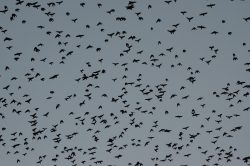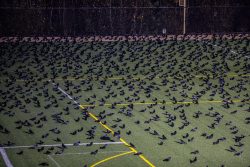
If you’ve ever looked towards the evening sky at University of Washington’s Bothell campus, you’ve probably witnessed the dark river of crows swarming above; and if you haven’t seen it, you’ve certainly heard it. Every night, 10 to 15 thousand crows make their nightly migration to the campus for a giant crow sleepover. According to John Marzluff, professor at UW School of Environmental and Forest Sciences, this nightly migration to a roost is a property of many corvids — the family of birds that includes crows, ravens, rooks, jackdaws, jays, magpies, treepies, choughs and nutcrackers. In particular, crows and ravens embark on these nightly journeys.
This spectacular phenomenon is a global one that extends far beyond the Bothell campus, all the way to Europe and farther. But why do they all come together like this, and why are there so many at Bothell? According to Marzluff, the answer is actually quite simple: safety.
“They go to a roost because it’s safer than sleeping out on their own where they’re spread out over many owl territories, or near raccoons, which are their predators,” he said from his office, plastered floor to ceiling in all things bird. “It’s better to be in a big group at night.”
UW’s Bothell campus happens to be an ideal location to safely spend the night. In 1997, the UW Bothell/Cascadia College campus restored the North Creek Wetland and essentially grew a perfect roost in doing so. The restoration site is full of woody trees, willows and thick vegetation, and is close to Lake Washington. All these characteristics make for a crow haven, and now the birds travel there from all over. “Birds from downtown Bellevue and even out east by Snohomish have basically all been able to use that roost because it is centrally located for all of them,” says Marzluff. “It was just the perfect spot and allowed for more birds to travel less.”

Such a mass conglomeration is fascinating, but it’s also extremely loud from crows communicating with each other using various advanced vocalizations. They will often warn each other of predators and other threats, providing extra protection and security to one another if there’s a disturbance to the roost. Additionally, crows have a remarkable ability to remember human faces and will recognize a person who has threatened them for as long as 17 years after the incident. Getting too close to a nest, interacting with a dead bird or otherwise harming a crow will quickly turn you into a perceived threat and the crows will communicate that to each other.
But they don’t just remember our faces out of threats; crows are also watching and learning from humans, and they adjust their behavior to better live in reciprocity with people. In turn, they provide services for us such as removing pests from our lawns and neighborhoods, and they have also impacted our culture by stimulating our thoughts, language, art and religion. Marzluff mused that crows “have a mutually reinforcing effect on our culture and we on theirs. They’ve had big effects on humans, and if you start to appreciate that long interaction and the ways they have impacted us, they become a pretty interesting species.”
This list of interactions and influences from crows on humans — and vice-versa — goes on. Scarecrows have historically been used to protect our crops from foraging of crows, and the Makah Tribe used them on their salmon drying racks to scare the birds away. Now, lasers and cannons are often used instead because crows learn human tactics and adjust to them. Marzluff says we’ve always been in an “arms race” with the birds that keep learning better ways to eat the crops we try to protect. Crows can easily alter their foraging techniques to human behaviors too, and are even known to drop nuts in front of cars to get run over and cracked open for them to eat. Their scavenging has also impacted our behaviors of “burying the dead, removing them from the battlefield, and taking care of them after a plague,” says Marzluff. Words and sayings like “crowbar” “crowfeet” “as the crow flies” and “something to crow about” are all aspects of crows that are ingrained in our language. Some religions even see ravens and crows as tricksters, creators or important informers. It is clear how much crows have swayed human culture, and their behaviors have always fascinated and perplexed us.
So, the next time you visit the Bothell campus at dusk, let the vast sky of birds inspire wonder and stimulate your thoughts. Look to the sky and see a truly spectacular group of animals exhibiting advanced social behaviors and learning. Let your curiosity soar with the flapping wings of the crows, and don’t forget to be nice, for they are watching, and they will remember.
Learn more about the crows at UW Bothell, including how you can observe this phenomenon in person on campus.

